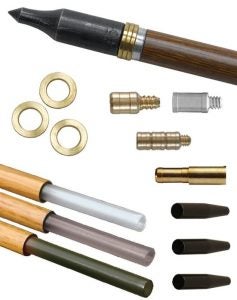
Arrow weight is a major factor affecting the behavior of your bow’s performance. Depending on the results you hope to achieve, you may want to change the overall weight of a finished arrow. Target archers are generally looking for speed to decrease the arc of the arrow’s flight. On the other hand, bowhunters often prefer a heavier arrow that increases momentum and results in better penetration on big game.
There are many choices to help you achieve the proper arrow weight for your specific archery needs. Changing shafts, adding weight tubes, and using insert weight systems are just a few ways to alter a finished arrow weight. Keep in mind that anything changed on an arrow has an impact on the dynamic spine, which changes how it shoots from your bow. Dynamic spine is the flexing of an arrow during arrow flight as it clears the riser of the bow. A weak arrow will flex too much and an arrow that is too stiff won’t flex enough.
The arrow spine selected needs to be correct in order to have the arrow fly properly and hit where you are aiming. It may take some fine tuning by adjusting arrow weight to get the best performance. Adding weight to the front of an arrow will have a significant effect weakening an arrow’s dynamic spine as it changes the amount of force needed to push the arrow. Using weight tubes distributes the added weight over the entire length of the arrow and changes the dynamic spine minimally.
Methods of changing overall arrow weight:

Shafts:
The first step is selecting the proper weight shaft for the desired results. Even though the static spine is the same, many manufacturers will offer models in different GPI (grains per inch). By calculating the GPI for a finished arrow length and combining the weight of all the components, you can get a close idea what to expect for a finished arrow weight.
There are specifically designed shafts for target shooting with a low GPI, like the Carbon Express Maxima Pro RZ carbon arrow shafts. These shafts help take out some of the guesswork for aiming by providing a flat shooting arrow. On the other hand, some shafts offer a heavy GPI for hunting; like the Carbon Express PileDriver DS Hunter shafts and will aid in penetration for the hunter. Tapered shafts, such as the GrizzlyStik Momentum TDT carbon arrow shafts are made with weight forward of center (FOC). Using FOC to your advantage offers better penetration for hunting situations.
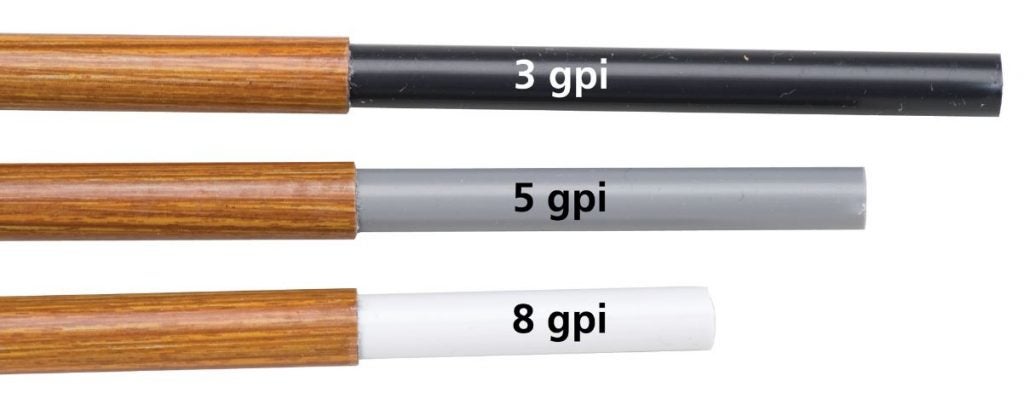
Weight Tubes:
Weight tubes offer a simple, yet effective way to add weight to an arrow. They provide more momentum with a minimal effect on dynamic spine. Offered in three, five, or eight GPI; weight tubes may be the solution to add weight without having to buy new arrows.
After deciding which weight tube to use, remove the nock end and slide the tube down the shaft. Place a mark at the end of the tube where it’s flush with the shaft and cut it at this location. Now slide the tube out of the shaft by approximately one inch. Align the shoulder of the nock even with the end of the tube (this is the distance that the nock slides into the shaft). Mark and cut the tube here, slide the tube back into the shaft, and re-insert the nock. This should give a tight fit with the weight tube installed.
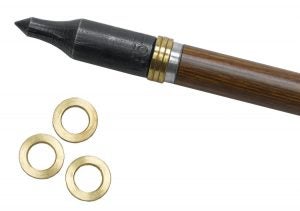
Points, Washers, and Collars:
The easiest of all methods to change arrow weight is to switch the point weight. There are many different weight screw-in and glue-on points. Adding weight up front can significantly change the dynamic spine of the arrow. For every 25 grains of weight added to the front, it weakens the dynamic spine by approximately 2 ½ lbs.
For more precise adjustments, there are some methods of changing weight. Brass washers weighing five grains each will allow for the finest of tuning. You can use up to three washers that fit over the threads and behind the shoulder of the point. Screwing the point to the shaft holds them in place. TECH TIP: Use a thread lock like Tip Jam Thread Bond for keeping your points secured in place.
Point collars and nock collars protect the ends of the shaft. While the primary purpose isn’t to change the dynamic spine, it can have an effect on it and something that should be kept in mind.
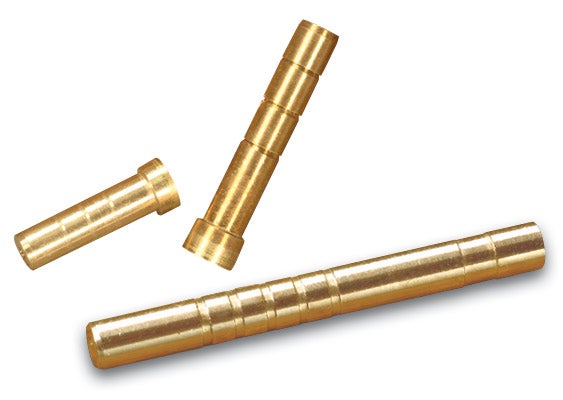
Inserts:
Heavy inserts have become the most common way to increase the weight of an arrow. Most standard inserts that come with your arrows are aluminum and only weigh 10 to 20 grains. Brass, heavy aluminum, or stainless steel inserts are made to fit a variety of shafts from .204″ inside diameter (ex: Easton Axis or GT Traditional Classic shafts), .234″ (ex: Beman Centershot), or .246″ ID (ex: 3Rivers Traditional Only). Weight of inserts can range from 50 grains up to 100 grains.

Increasing in popularity are insert weights. Most standard aluminum inserts come threaded on the back end of the insert and allow the use of modular weight systems. This means that they are flexible for fine tuning weight forward.
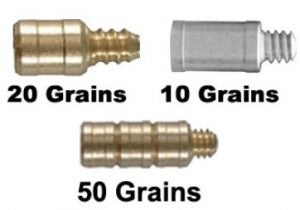
Gold Tip FACT Screw-in Weight Systems (shown) or the Black Eagle insert weights are good examples. The weights are built to the internal dimension of the shafts such as .246″/.244″ ID, .204″ ID or the latest .166″ ID and are available in 10, 20, and 50 grains models. Screw-in weights can be used individually or stacked one upon another to achieve various weight unit combinations. Tip Jam is also recommended to keep the weights from vibrating loose.
If you want to adjust or change the weight, you use the adjustment wrench. Simply remove the nock and slide the wrench down the shaft to thread or remove additional weights. The biggest advantage to these systems is that you can keep the same screw-in point or broadhead weight. Being able to adjust and having the ability to easily fine tune with the weight combinations are all benefits.
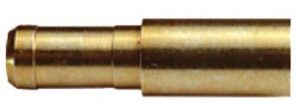
Nock Weights:
Nock weight systems work the same as insert weights except the weight is placed at the back of the shaft. The main function is to change the arrow’s FOC giving more options for tuning. Adding weight to the back of the arrow will act to stiffen the arrow’s dynamic spine. It takes less weight at the nock end of the arrow to impact the spine of the arrow, compared to adding weight to the front of the arrow.

Wood Shafts:
While there aren’t as many options to customize the weight to wood arrows, there are a few worth mentioning. Woody Weights look similar and glue to the front of the wood shaft the same as glue-on field points. They are available in several different weights ranging from 75 to 200 grains and can change the overall length of the shaft by a small amount. The standard 5° point taper allows gluing of points and broadheads directly to the weights.
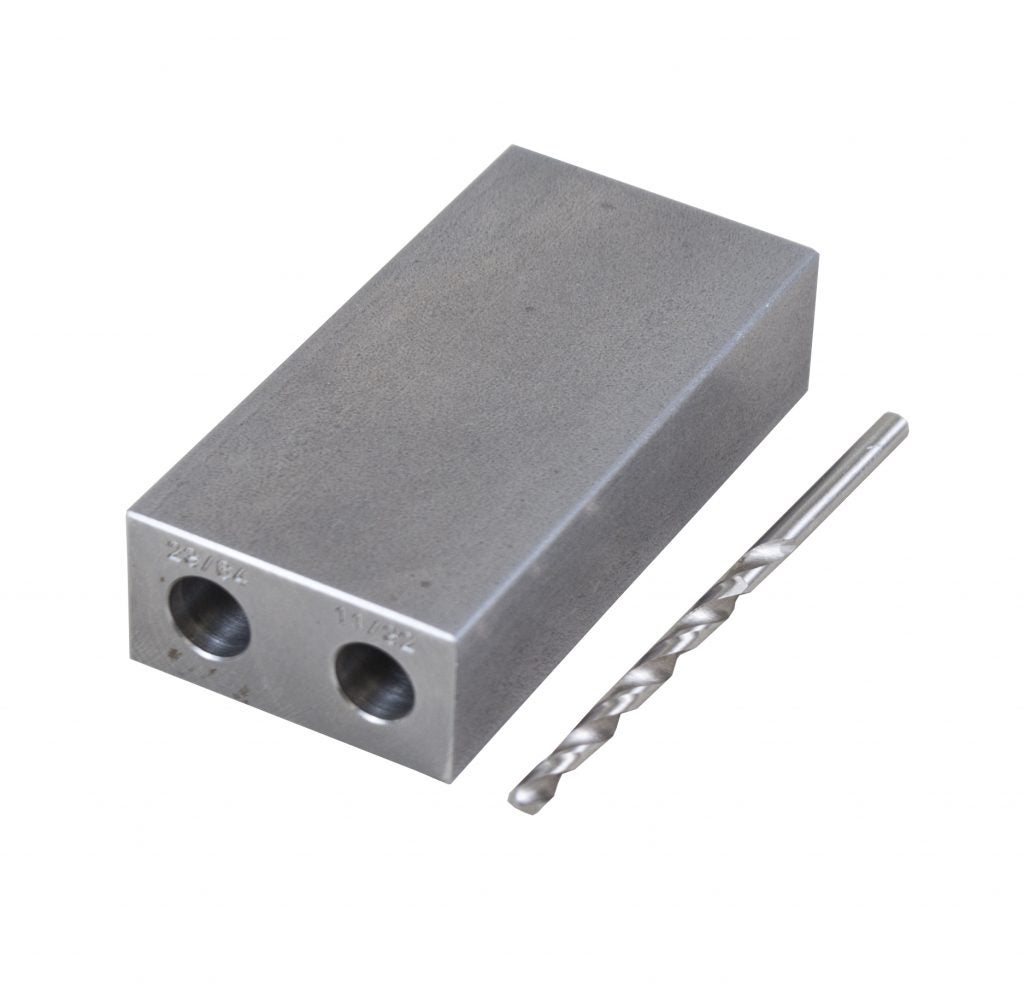
Another option is the Internal Footing Jig that requires drilling a hole in the center of the shaft. Then inserting a metal rod into the hole adds weight up front. Changing the length and type of rod allows for customization of the overall weight. These copper rods weigh roughly 19 grains per inch while the tungsten rods weigh roughly 33 grains per inch.
Summary:
As you can see, there are a lot of arrow weight systems available to change the overall arrow weight. Depending on your needs, some will have minimal effects and others will significantly alter the arrow’s flight. If you have questions, feel free to give us a call at 1-260-587-9501 or send us an email at info@3riversarchery.com.
By R. Strong
[subscribe2]














.jpg)
